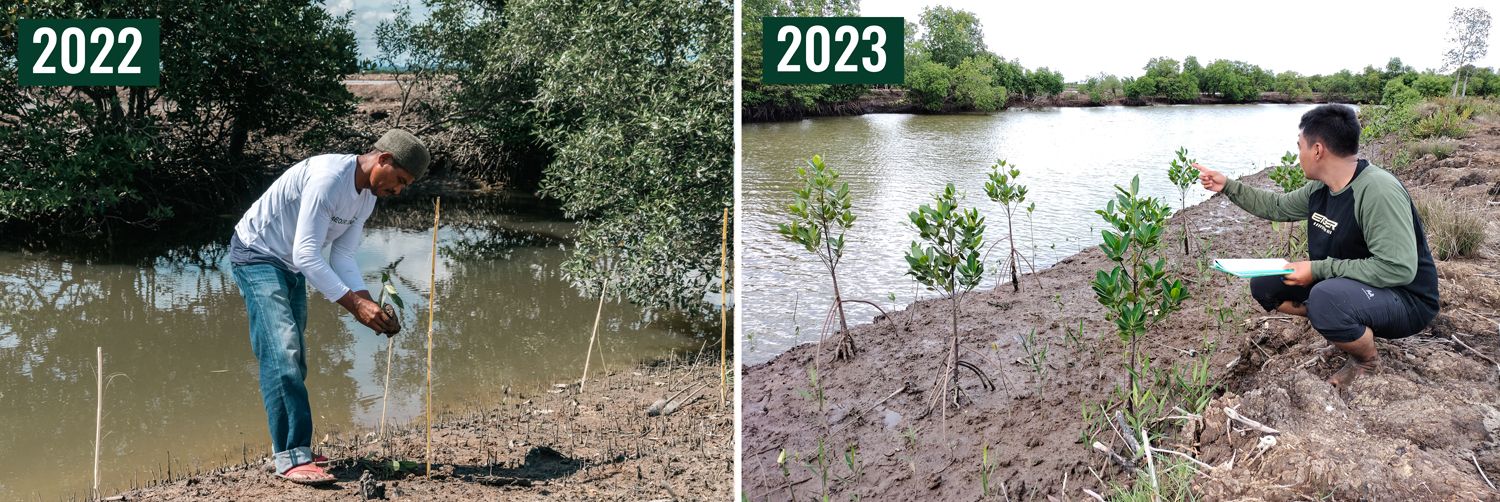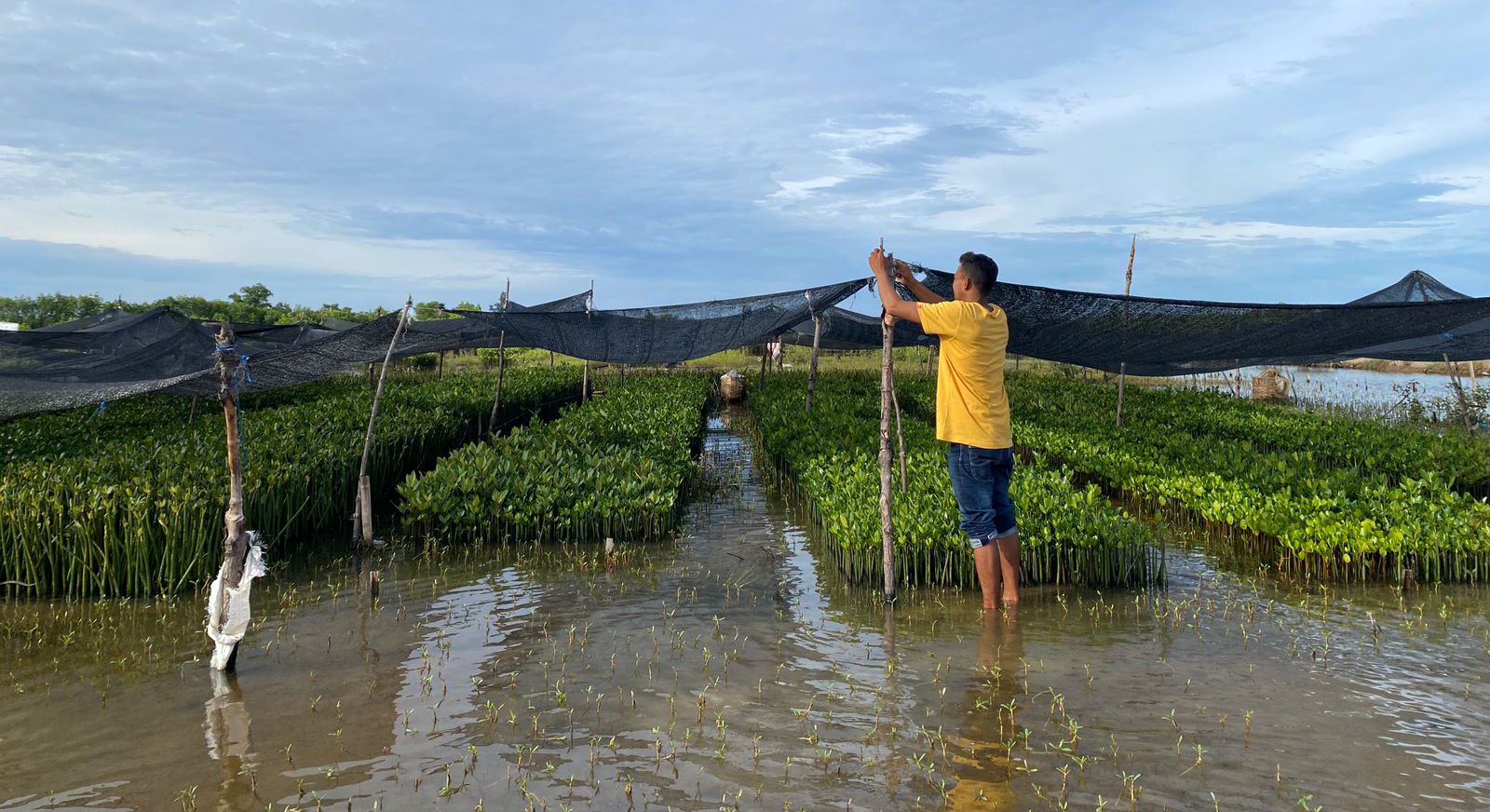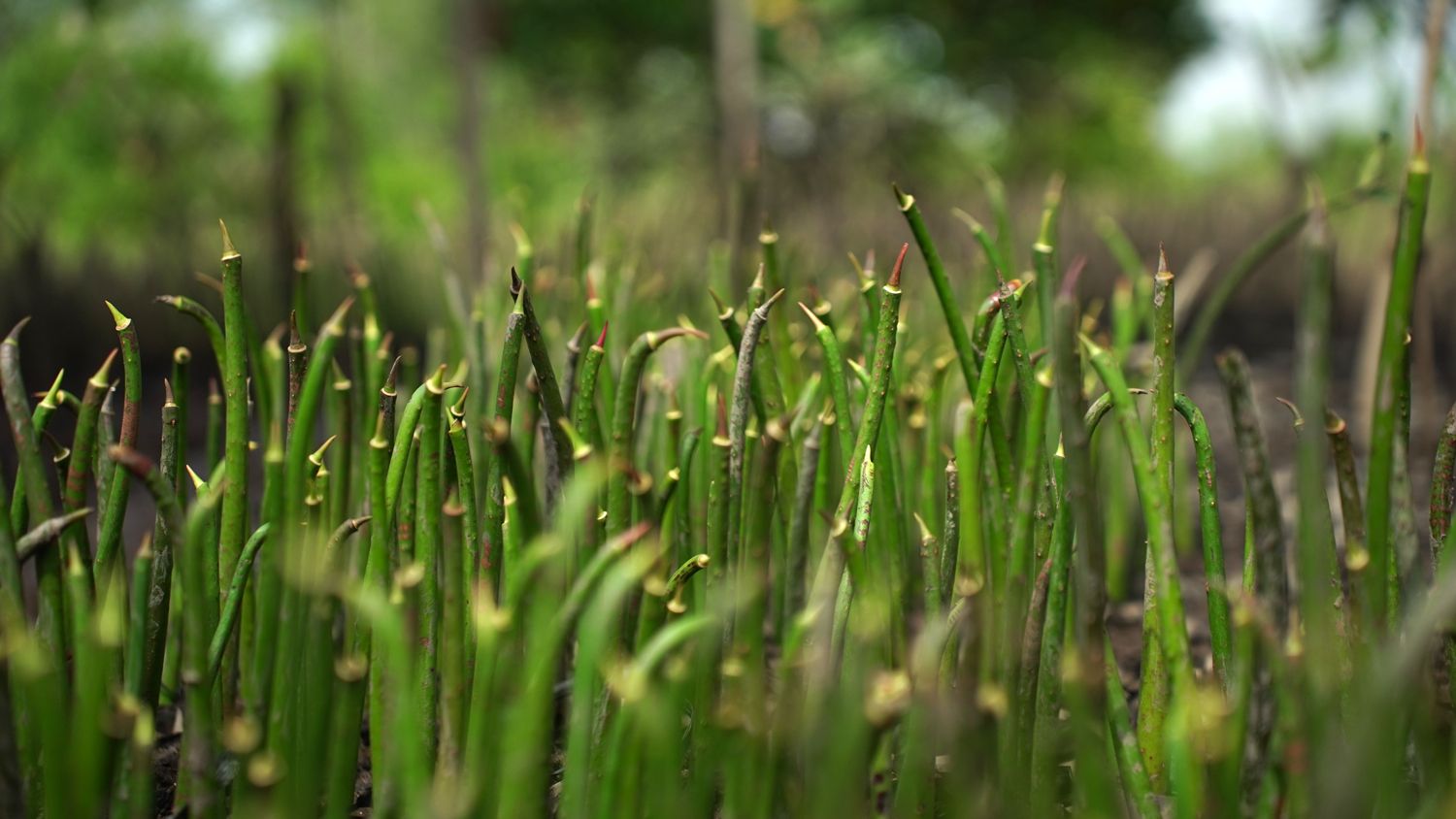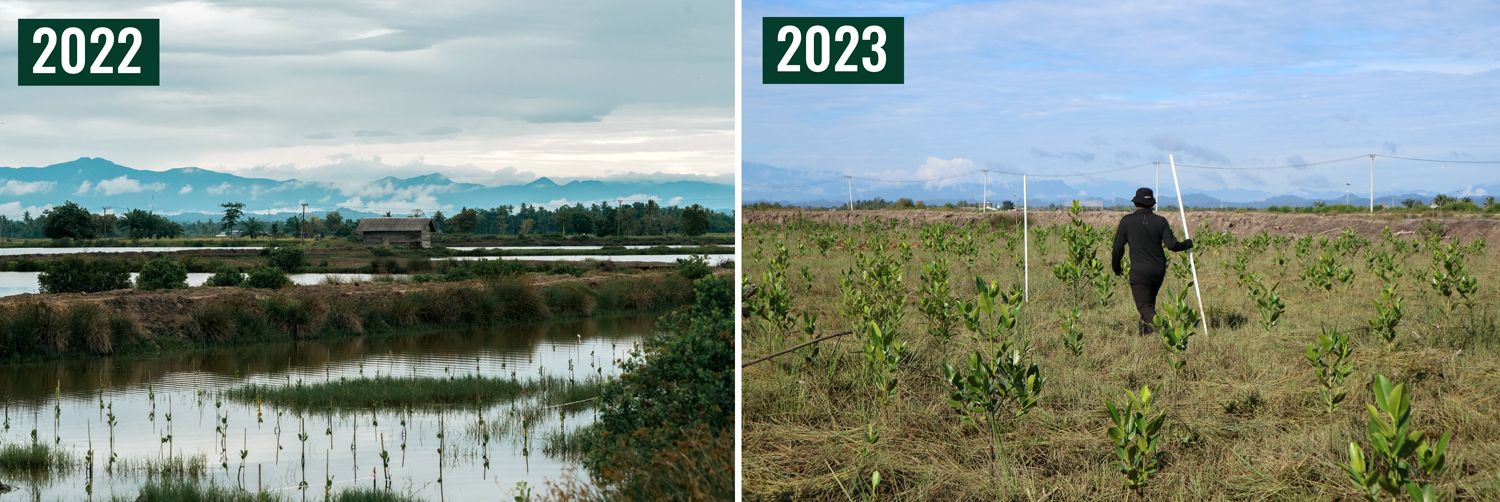In Sumatra, Indonesia, Reforest'Action has been working with local NGO Yakopi to restore the mangroves since 2021. An audit carried out in November 2023 analysed the results of the project's first two years, during which 880,013 mangrove trees were planted. In addition to its remarkable ecological impact, particularly in terms of biodiversity, the project has also helped to improve economic livelihoods and diversify income-generating activities, as well as raising environmental awareness. All these benefits are now contributing to the development and sustainability of the communities that depend on the mangroves on a daily basis.

The project's major achievements since 2021
A positive assessment at the end of the first two years of project deployment
In December 2023, an audit carried out by Reforest'Action made it possible to verify in particular:
- the progress of the project and the geolocation of the plots,
- the number of trees planted, their density and the diversity of species,
- the success rate of the plantations,
- the level of technical expertise of the project leader in terms of planning, structuring, soil preparation, transport of seedlings, waste collection, etc.
- the involvement of local communities in the project,
- and their perception of the socio-economic benefits.
Carried out annually for the first 5 years of project activities, these audits also help to support the project implementer in a continuous improvement process and to use Reforest'Action's expertise in the field to strengthen the implementation of the project. In fact, the December 2023 audit showed that the Yakopi team had made significant improvements and increased efficiency compared with the previous year, thanks to the implementation of the recommendations made during the October 2022 audit.
These included resolving geo-referencing issues and improving tree conditions in the field. With regard to mangrove restoration efforts, the audit highlighted the excellent health of the planted trees, with a survival rate of nearly 90% for the entire two years of project implementation, and the rich biodiversity of the project area, which now boasts a multitude of identified species, including birds, insects, fish, mammals and reptiles, testifying to the ecological vitality of the restored mangrove ecosystems in Sumatra. The project also actively engaged with local communities to improve socio-economic livelihoods through various community development programs.

From 2021 to 2022, the project successfully enters its initial phase
In the first year of the project (2021-2022), 376,622 mangrove trees were planted over an area of 132.69 hectares. The strategic focus has been on a total of 16 villages, including Abeuk Geulante, Cinta Raja, Pangkalan Batu, Dogang and Pasar Rawa, where collaborative efforts with local communities and the active participation of local people in mangrove restoration activities have been encouraged.
Yakopi's commitment to local communities was reflected in the organisation of 29 village meetings, attended by 391 people. A total of 14 training activities were carried out during the project, including 5 sessions focusing on nursery and mangrove restoration activities. These initiatives helped to build capacity and disseminate knowledge among the local population.
In terms of job creation, the project enabled 439 people to be employed throughout the season, in particular within the nursery teams (236 people) and the planting teams (185 members). In addition, 18 villagers took part in community patrol activities, aimed at surveying the mangroves and reporting any deforestation activity.
Aware of the importance of education in the fight against climate change, the Yakopi team launched an awareness-raising programme in schools in the provinces of Aceh and North Sumatra. Around 408 pupils from 9 schools were made aware of the environmental and socio-economic issues involved in conserving mangroves. Yakopi has also launched an ecotourism initiative in the village of Dogang, which aims to use the natural resources of the mangroves for tourism purposes while prioritising biodiversity conservation. The initiative involved 45 local participants. In its first year, the project's activities had a direct impact on 1,833 beneficiaries.

From 2022 to 2023, the project increases its scope and attracts community support
In the second year of the project (2022-2023), 503,551 mangrove trees were planted over an area of 105.58 hectares. Yakopi has continued its actions in the 16 villages associated with the first year of the project, while developing mangrove restoration in two additional villages, thus extending its commitment to a total of 18 villages.
Consultation and integration of local communities continued with 19 village meetings involving 170 participants. Training initiatives were extended during the season, with a total of 26 sessions. Of these, 11 focused on nursery training, 12 on environmental education and 3 on group discussions. This comprehensive approach aims to improve technical skills and environmental awareness among local people.
The second year of the project generated jobs for a total of 365 people, including 193 in the nursery team, 130 in the planter team and 42 in the community patrol team, which aims to monitor and protect the restored mangrove ecosystems.
Yakopi's commitment to education has reached 577 pupils in 12 schools in the provinces of Aceh and North Sumatra. At the same time, the ongoing ecotourism programme in the village of Dogang has attracted 89 residents and served as a model for sustainable tourism throughout the region.
These various collaborative initiatives underline Yakopi's holistic approach, which combines community engagement, education, sustainable economic programs and efforts to conserve the restored mangroves, to ensure the project's lasting success. Throughout its second year, the project has directly benefited 1,883 people.

A rigorous methodology for selecting plots for restoration
Identifying planting sites
Before committing to the restoration of a particular area, Yakopi carries out an in-depth examination of a number of factors. A GIS (Geographic Information System) analysis is crucial to assess the historical use of the land over the last five years. This analysis is part of the land assessment process and used to determine whether the land has been deforested recently or whether it has undergone major changes in terms of land use. The aim is to determine whether the area can be considered a suitable habitat for mangroves. In addition, during this study, attention is paid to the surrounding vegetation, in order to identify the dominant species of the ecosystem and carefully select the mangrove species to be planted during future restoration actions.
Based on these analyses, the Yakopi GIS team then identifies potential plots, the feasibility of which is then studied by the field team. Land tenure and social conditions are then taken into account through various village meeting activities and socialization, in particular to ensure that the land has clear administrative boundaries and does not conflict with the boundaries of adjacent villages. If it is certain that the situation is clear, Yakopi draws up a 20-year memorandum of understanding with the village stakeholders, following which restoration activities can begin.
In practical terms, during the first two years of the project, the sites selected for mangrove restoration work are made up of two types of land:
- Heavily degraded plots, deforested in previous years, on the banks of rivers and river estuaries. The aim of planting mangroves is to restore the original mangrove and its ecosystem services, such as fixing unstable soils and combating erosion and rising water levels.
- Abandoned or still active fishponds. Planting takes place around and inside the ponds, with the aim of transforming them into sylvo-fisheries ponds, which make the most of the mangrove's natural wealth of biodiversity while supporting local economic livelihoods. Mangrove existence improves water quality and help to increase fish production. Planting around ponds serves the dual purpose of maintaining the structural integrity of the pond and providing a sustainable source of food for aquatic life.
Selecting the species to be planted
As a veritable amphibious forest, the mangrove is a plant formation that covers 75% of the coasts, deltas and estuaries of the intertropical regions. It is mainly made up of mangrove trees, of which there are almost 100 different species. All have the capacity to adapt to high salinity, submerged roots and low soil oxygenation due to silt. Rhizophora, for example, have stems that anchor directly in the mud. In Avicennia, vertical stems (pneumatophores) have small slits that open at low tide to allow respiration.
As part of the Yakopi project, four distinct species of mangrove were selected on the basis of the vegetation observed in the project area. The predominant species is Rhizophora stylosa, followed by Avicennia sp, Rhizophora apiculata and Rhizophora mucronata. This diversity of species contributes directly to the ecological richness and resilience of the restoration efforts.

Restoring mangroves: from nurseries to monitoring tree growth
Mangrove nursery production
To supply the nurseries, Yakopi works with local communities to harvest propagules. A propagule is a multicellular structure intended to be released to ensure the multiplication and propagation of the organism that produces it. Mostly, mangrove propagules are long tubers shaped. They can be harvested from local mature trees and then planted in nurseries to generate new shoots. To promote the health and vitality of young mangroves, they are kept for a time under shading nets and irrigated if necessary after being transported from the nursery to the planting site. This helps to alleviate the stress resulting from the move and acclimatize them to their new habitat.

Planting trees on selected sites
The method of planting mangroves is defined according to the unique conditions of each site, taking particular account of tide levels and the strength of the current. In areas subject to strong waves, the plantations are densely planted and moored along the coast by a stake-bamboo placed at the level of each plant, ensuring optimum stability and resistance to wind and sea currents. In more moderate erosion conditions, a system with two plants per stake and a lower planting density is applied to limit the impact of abrasion. Mangrove planting does not depend on the season (dry or wet) but on the rhythm of the tides, and is carried out at low tide to facilitate planters' access to restoration sites.

Monitoring and maintenance of restored mangrove plots
Successful mangrove planting results in lush tree growth, with rigid stems condition, bright green leaves and the emergence of new shoots. After planting, growth is monitored by Yakopi to measure various environmental parameters and assess the survival rate. In the event of tree mortality, due for example to wave impact, the presence of barnacles, interference from crabs or exposure to parasites, Yakopi takes a proactive approach to replanting and ensures that any trees that do not survive are quickly replaced. With an average survival rate of 90% reported by the Reforest'Action audit in December 2023, the success achieved is not only a testament to the effective implementation of the project, but also highlights our partner's ability to overcome challenges and ensure the long-term success of mangrove restoration.

Assessing the socio-economic benefits for local communities
A strong commitment to the community
Met by Reforest'Action during the November 2023 audit mission, community members actively involved in the nursery and planting teams express a high level of satisfaction and enthusiasm about the multiple benefits of the project. These benefits include improved economic livelihoods, increased environmental awareness facilitated by training and socialization initiatives, and the development of cohesive social bonds within the villages. The prevailing feeling in the community is one of gratitude and enthusiasm for the existence of the project, with a desire to see it continue and expand.

Development of income-generating activities based on mangroves
In particular, income-generating activities based on the natural resources of the mangrove have diversified over the two years of the project. This expansion illustrates Yakopi's strategic approach to sustainable economic development within communities in order to foster their resilience and adaptability.
The nypa palm, which grows naturally in the mangrove, in association with various species of mangrove, is the only palm of its kind that can grow in intertidal water course system. Traditionally, it was used to create plant fibre roofs. But this practice required the complete felling of the tree, thereby contributing to the deforestation of mangrove ecosystems. With a view to preserving the integrity of the forests, Yakopi came up with a solution that would enable local communities to continue to integrate nypa into their economy without cutting down the palm trees, which are invaluable for maintaining the muddy soils that they help to fix with their roots. As a result, the production of palm sugar, made from the sap of the nypa tree, has become widespread in the villages associated with the project. Particularly prolific, each nypa stem can secrete up to a litre of sap a day, which can be consumed directly as an energy drink. It can also be cooked to extract a natural sugar used for cooking or sold on local markets. The fruit is also consumed by the villagers, contributing to their food security. The product is now attracting local consumers, and thanks to this economic sector, the villagers benefit from an additional income.

Other products derived from the natural riches of mangroves have been developed as part of the project led by Yakopi, such as the nypa sweet-candied fruits, but also shrimp chips or cuttlefish chips derived from sylvo-fisheries ponds or naturally harvested near mangrove forest through traditional fishing. All these mangrove by-products are now being produced and marketed locally thanks to the project and are making a significant contribution to the economic well-being of local communities.